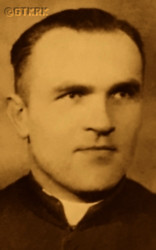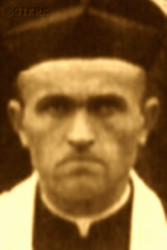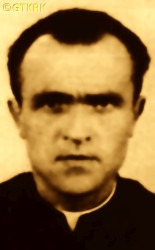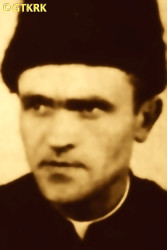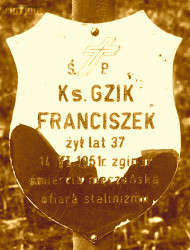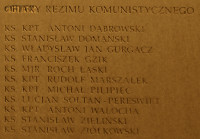Roman Catholic
St Sigismund parish
05-507 Słomczyn
85 Wiślana Str.
Konstancin deanery
Warsaw archdiocese, Poland
full list:
displayClick to display full list

searchClick to search full list by categories
wyświetlKliknij by wyświetlić pełną listę po polsku

szukajKliknij by przeszukać listę wg kategorii po polsku

Martyrology of the clergy — Poland
XX century (1914 – 1989)
personal data
surname
GZIK
forename(s)
Francis (pl. Franciszek)
function
diocesan priest
creed
Latin (Roman Catholic) Church RCmore on
en.wikipedia.org
[access: 2014.09.21]
diocese / province
Lublin diocesemore on
pl.wikipedia.org
[access: 2013.05.19]
RC Military Ordinariate of Polandmore on
en.wikipedia.org
[access: 2014.12.20]
honorary titles
„Cross of National Armed Actions”more on
„Cross of National Armed Actions”
(24.04.1995)
date and place
of death
14.06.1951

Racibórztoday: Racibórz urban gm., Racibórz pov., Silesia voiv., Poland
more on
en.wikipedia.org
[access: 2021.04.02]
details of death
After German and Russian invasion of Poland in 09.1939 and start of the World War II, after start of German occupation, unable to return to continue his theology studies settled in family house in Potok Wielki.
There collaborated with Polish clandestine resistance National Armed Forces NSZ.
In 1943 in Nowy Sącz was clandestinely ordained by Bp Marian Fulman, deported there by the Germans from his diocese.
After end of World War II hostilities and start of Russian occupation organized in 08/09.1948 a pilgrimage of his Komarów parishioners to Częstochowa / Jasna Góra Marian shrine with a prayer „For free Poland”.
Arrested during the night of 08‐09.02.1949 in Mircze parish by Commie‐Nazi UB, a unit of Russian NKVD functioning in Russian–controlled prl state.
Accused of „depravity towards underage girls”.
Jailed in Hrubieszów prison and — later — in UB station at Krótka Str. in Lublin.
On 24.07.1949 moved to Lublin castle prison.
On 07.02.1950 (according to some sources on 09.09.1949) sentenced by a Commie‐Nazi Regional Court in Lublin to 10 years in prison.
On 14.10.1950 moved to Racibórz prison.
There forced to sign depositions against Polish Catholic church's Episcopate.
There also, in Commie‐Nazi party offices on Ogrodowa Str. in Racibórz, murdered by UB officers.
alt. details of death
According to some sources after half a year imprisonment in Lublin Castle prison forced by Commie‐Nazi UB to slave in Racibórz mines, where perished for exhaustion and illnesses.
cause of death
murder
perpetrators
Russians / Poles
sites and events
Lublin (Castle)Click to display the description, Ribbentrop‐MolotovClick to display the description, Pius XI's encyclicalsClick to display the description
date and place
of birth
28.06.1915

Potok Wielkitoday: Potok Wielki gm., Janów Lubelski pov., Lublin voiv., Poland
more on
en.wikipedia.org
[access: 2021.08.20]
alt. dates and places
of birth
02.12.1914
parents
GZIK John
🞲 ?, ? — 🕆 ?, ?

🞲 ?, ? — 🕆 ?, ?
presbyter (holy orders)
ordination
29.06.1943

Nowy Sącztoday: Nowy Sącz pov., Lesser Poland voiv., Poland
more on
en.wikipedia.org
[access: 2021.04.01]
positions held
1949
administrator — Mirczetoday: Mircze gm., Hrubieszów pov., Lublin voiv., Poland
more on
en.wikipedia.org
[access: 2021.09.29] ⋄ Our Lord's Resurrection RC parish ⋄ Tyszowcetoday: Tyszowce gm., Tomaszów Lubelski pov., Lublin voiv., Poland
more on
en.wikipedia.org
[access: 2020.09.24] RC deanery
1948 – 1949
vicar — Komarówtoday: Komarów‐Osada, Komarów‐Osada gm., Zamość pov., Lublin voiv., Poland
more on
en.wikipedia.org
[access: 2021.12.19] ⋄ Holy Trinity RC parish ⋄ Tomaszów Lubelskitoday: Tomaszów Lubelski gm., Tomaszów Lubelski pov., Lublin voiv., Poland
more on
en.wikipedia.org
[access: 2021.08.20] RC deanery
1946 – 1948
vicar — Tarnogóratoday: Izbica gm., Krasnystaw pov., Lublin voiv., Poland
more on
en.wikipedia.org
[access: 2021.08.20] ⋄ St Sophie RC parish ⋄ Krasnystawtoday: Krasnystaw urban gm., Krasnystaw pov., Lublin voiv., Poland
more on
en.wikipedia.org
[access: 2020.12.03] RC deanery
1944 – 1946
vicar — Urzędówtoday: Urzędów gm., Kraśnik pov., Lublin voiv., Poland
more on
en.wikipedia.org
[access: 2021.08.20] ⋄ St Nicholas the Bishop and Confessor RC parish ⋄ Kraśniktoday: Kraśnik urban gm., Kraśnik pov., Lublin voiv., Poland
more on
en.wikipedia.org
[access: 2021.08.20] RC deanery — prefect
1943 – 1944
vicar — Dzierzkowicetoday: Dzierzkowice‐Rynek, Dzierzkowice gm., Kraśnik pov., Lublin voiv., Poland
more on
en.wikipedia.org
[access: 2021.12.19] ⋄ St Stanislav the Bishop and Martyr and St Mary Magdalene RC parish ⋄ Kraśniktoday: Kraśnik urban gm., Kraśnik pov., Lublin voiv., Poland
more on
en.wikipedia.org
[access: 2021.08.20] RC deanery
till 1939
student — Lublintoday: Lublin city pov., Lublin voiv., Poland
more on
en.wikipedia.org
[access: 2021.08.20] ⋄ philosophy and theology, Theological Seminary
sites and events
descriptions
Lublin (Castle): During World War II, the Germ. Gefängnis der Sicherheitspolizei und des Sicherheitsdienst Lublin (Eng. Police and Security Service SD Prison), through which c. 40,000‐80,000 Poles passed during the German occupation, mostly members of Polish clandestine independence organizations (part of the Polish Clandestine State), before being sent by the Germans to concentration camps. The inmates were held in inhumane conditions, in overcrowded cells — up to 3,000 were held at one time in the prison designed for 700 people — where they were starved, harassed, and disease was rampant. During interrogations were tortured. Many were murdered — the prison housed the genocidal Germ. Sondergericht (Eng. special court), which issued serial death sentences after a trial lasting several minutes. C. 2,200 perished during the investigation or in the prison; 4,500 were murdered in secret executions in the vicinity of Lublin. When the Russians were fast approached Lublin in 08.1944, c. 1,500 prisoners were sent to the KL Lublin concentration camp, where were murdered, and on 22.07.1944, after a few hours prior to escape, c. 300 remaining were murdered in the prison itself. After the expulsion of the Germans in 1944, the prison was first run by Russians, then UB, the Polish branch of the Russian NKVD, and 32,000‐33,000 soldiers of the Home Army AK, part of the Polish Clandestine State, and the National Armed Forces NSZ, fighting against the Russian occupation, were detained there (in similar conditions to the Germans — in 04.1945 c. 8,000 people were held in the prison) and tortured. C. 515 were sentenced to death and 333 were murdered. The prison began to be liquidated in 02.1954. (more on: en.wikipedia.orgClick to attempt to display webpage
[access: 2015.09.30])
Ribbentrop‐Molotov: Genocidal Russian‐German alliance pact between Russian leader Joseph Stalin and German leader Adolf Hitler signed on 23.08.1939 in Moscow by respective foreign ministers, Mr. Vyacheslav Molotov for Russia and Joachim von Ribbentrop for Germany. The pact sanctioned and was the direct cause of joint Russian and German invasion of Poland and the outbreak of the World War II in 09.1939. In a political sense, the pact was an attempt to restore the status quo ante before 1914, with one exception, namely the „commercial” exchange of the so‐called „Kingdom of Poland”, which in 1914 was part of the Russian Empire, fore Eastern Galicia (today's western Ukraine), in 1914 belonging to the Austro‐Hungarian Empire. Galicia, including Lviv, was to be taken over by the Russians, the „Kingdom of Poland” — under the name of the General Governorate — Germany. The resultant „war was one of the greatest calamities and dramas of humanity in history, for two atheistic and anti‐Christian ideologies — national and international socialism — rejected God and His fifth Decalogue commandment: Thou shall not kill!” (Abp Stanislav Gądecki, 01.09.2019). The decisions taken — backed up by the betrayal of the formal allies of Poland, France and Germany, which on 12.09.1939, at a joint conference in Abbeville, decided not to provide aid to attacked Poland and not to take military action against Germany (a clear breach of treaty obligations with Poland) — were on 28.09.1939 slightly altered and made more precise when a treaty on „German‐Russian boundaries and friendship” was agreed by the same murderous signatories. One of its findings was establishment of spheres of influence in Central and Eastern Europe and in consequence IV partition of Poland. In one of its secret annexes agreed, that: „the Signatories will not tolerate on its respective territories any Polish propaganda that affects the territory of the other Side. On their respective territories they will suppress all such propaganda and inform each other of the measures taken to accomplish it”. The agreements resulted in a series of meeting between two genocidal organization representing both sides — German Gestapo and Russian NKVD when coordination of efforts to exterminate Polish intelligentsia and Polish leading classes (in Germany called «Intelligenzaktion», in Russia took the form of Katyń massacres) where discussed. Resulted in deaths of hundreds of thousands of Polish intelligentsia, including thousands of priests presented here, and tens of millions of ordinary people,. The results of this Russian‐German pact lasted till 1989 and are still in evidence even today. (more on: en.wikipedia.orgClick to attempt to display webpage
[access: 2015.09.30])
Pius XI's encyclicals: Facing the creation of two totalitarian systems in Europe, which seemed to compete with each other, though there were more similarities than contradictions between them, Pope Pius XI issued in 03.1937 (within 5 days) two encyclicals. In the „Mit brennender Sorge” (Eng. „With Burning Concern”) published on 14.03.1938, condemned the national socialism prevailing in Germany. The Pope wrote: „Whoever, following the old Germanic‐pre‐Christian beliefs, puts various impersonal fate in the place of a personal God, denies the wisdom of God and Providence […], whoever exalts earthly values: race or nation, or state, or state system, representatives of state power or other fundamental values of human society, […] and makes them the highest standard of all values, including religious ones, and idolizes them, this one […] is far from true faith in God and from a worldview corresponding to such faith”. On 19.03.1937, published „Divini Redemptoris” (Eng. „Divine Redeemer”), in which criticized Russian communism, dialectical materialism and the class struggle theory. The Pope wrote: „Communism deprives man of freedom, and therefore the spiritual basis of all life norms. It deprives the human person of all his dignity and any moral support with which he could resist the onslaught of blind passions […] This is the new gospel that Bolshevik and godless communism preaches as a message of salvation and redemption of humanity”… Pius XI demanded that the established human law be subjected to the natural law of God , recommended the implementation of the ideal of a Christian state and society, and called on Catholics to resist. Two years later, National Socialist Germany and Communist Russia came together and started World War II. (more on: www.vatican.vaClick to attempt to display webpage
[access: 2023.05.28], www.vatican.vaClick to attempt to display webpage
[access: 2023.05.28])
sources
personal:
nsz.com.plClick to attempt to display webpage
[access: 2013.02.15], raciborz.naszemiasto.plClick to attempt to display webpage
[access: 2013.02.15], gokurzedow.plClick to attempt to display webpage
[access: 2020.06.05]
bibliographical:
„Lexicon of the clergy vicimised in prl in 1945‐1989”, collective work edited by Jerzy Myszor, Warsaw, 2002
original images:
www.parafiakomarow.plClick to attempt to display webpage
[access: 2014.08.14], gokurzedow.plClick to attempt to display webpage
[access: 2020.06.05], gokurzedow.plClick to attempt to display webpage
[access: 2020.06.05], gokurzedow.plClick to attempt to display webpage
[access: 2020.06.05], www.nowiny.rybnik.plClick to attempt to display webpage
[access: 2014.01.28]
LETTER to CUSTODIAN/ADMINISTRATOR
If you have an Email client on your communicator/computer — such as Mozilla Thunderbird, Windows Mail or Microsoft Outlook, described at WikipediaPatrz:
en.wikipedia.org, among others — try the link below, please:
LETTER to CUSTODIAN/ADMINISTRATORClick and try to call your own Email client
If however you do not run such a client or the above link is not active please send an email to the Custodian/Administrator using your account — in your customary email/correspondence engine — at the following address:

giving the following as the subject:
MARTYROLOGY: GZIK Francis
To return to the biography press below:
 Click to return to biography
Click to return to biography








